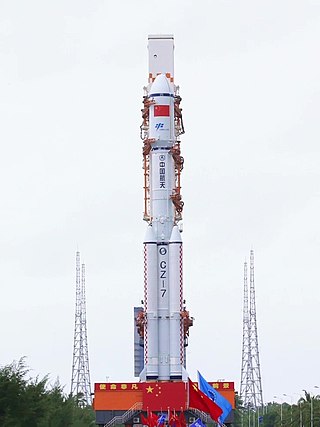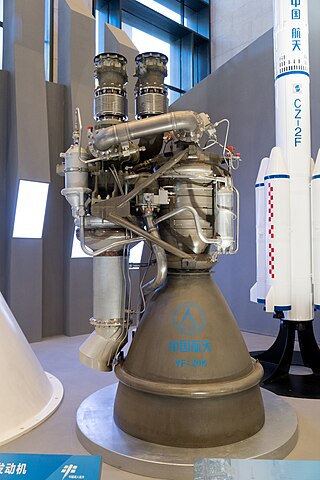Related Research Articles

The Jupiter-C was an American research and development vehicle developed from the Jupiter-A. Jupiter-C was used for three uncrewed sub-orbital spaceflights in 1956 and 1957 to test re-entry nosecones that were later to be deployed on the more advanced PGM-19 Jupiter mobile missile. The recovered nosecone was displayed in the Oval Office as part of President Dwight D. Eisenhower's televised speech on November 7, 1957.

The Titan IIIC was an expendable launch system used by the United States Air Force from 1965 until 1982. It was the first Titan booster to feature large solid rocket motors and was planned to be used as a launcher for the Dyna-Soar, though the spaceplane was cancelled before it could fly. The majority of the launcher's payloads were DoD satellites, for military communications and early warning, though one flight (ATS-6) was performed by NASA. The Titan IIIC was launched exclusively from Cape Canaveral while its sibling, the Titan IIID, was launched only from Vandenberg AFB.
The Long March 1 (长征一号), also known as the Changzheng-1 (CZ-1), was the first member of China's Long March rocket family. Like the U.S.'s and the Soviet Union's first rockets, it was based on a class of ballistic missiles, namely the DF-4 class.
The Long March 1D was a member of China's Long March rocket family. During the 1990s CALT developed an improved version of the DF-4 to test the reentry vehicle warheads of the DF-31. They took advantage of this development and offered it as the Long March 1D for commercial application. The modifications included:

The YF-73 was China's first successful cryogenic liquid hydrogen fuel and liquid oxygen oxidizer gimballed engine. It was used on the Long March 3 H8 third stage, running on the simple gas generator cycle and with a thrust of 44.15 kilonewtons (9,930 lbf). It had four hinge mounted nozzles that gimbaled each on one axis to supply thrust vector control and was restart capable. It used cavitating flow venturis to regulate propellant flows. The gas generator also incorporated dual heat exchangers that heated hydrogen gas, and supplied helium from separate systems to pressurize the hydrogen and oxygen tanks. The engine was relatively underpowered for its task and the start up and restart procedures were unreliable. Thus, it was quickly replaced by the YF-75.

The Long March 6 or Chang Zheng 6 as in pinyin, abbreviated LM 6 for export or CZ 6 within China, is a Chinese liquid-fuelled launch vehicle of the Long March family, which was developed by the China Aerospace Science and Technology Corporation (CASC) and the Shanghai Academy of Spaceflight Technology (SAST). The rocket was developed in the 2000s, and made its maiden flight in 2015. As one of the new generation rocket family, the Long March 6 was designed to be a light capacity, "high-speed response" rocket, complementing the heavy lift Long March 5 and the mid-heavy lift Long March 7 rocket families. It is capable of placing at least 1,000 kg (2,200 lb) of payload into a Sun-synchronous orbit. The first stage of the Long March 6 was derived from the booster rockets being developed for the Long March 5 rocket. It is powered by a YF-100 engine, which generates 1,340 kN (300,000 lbf) of thrust from burning kerosene and LOX as rocket fuel and oxidiser. This was the first flight of the new engine design.

The Long March 7, or Chang Zheng 7 in pinyin, abbreviated LM-7 for export or CZ-7 within China, originally Long March 2F/H or Chang Zheng 2F/H, nicknamed Bingjian, is a Chinese liquid-fuelled launch vehicle of the Long March family, developed by the China Aerospace Science and Technology Corporation (CAST). It made its inaugural flight on 25 June 2016.

The Algol family of solid-fuel rocket stages and boosters is built by Aerojet and used on a variety of launch vehicles. It was developed by Aerojet from the earlier Jupiter Senior and the Navy Polaris programs. Upgrades to the Algol motor occurred from 1960 until the retirement of the Scout launch vehicle in 1994.

The YF-20 is a Chinese liquid-fuel rocket engine burning N2O4 and UDMH in a gas generator cycle. It is a basic engine which when mounted in a four engine module forms the YF-21. The high altitude variation is known as the YF-22 is normally paired with the YF-23 vernier to form the YF-24 propulsion module for second stages. New versions when used individually for booster applications are called YF-25.
The YF-23 is a liquid rocket vernier engine, burning N2O4 and UDMH. It is used in along the YF-22 to form the YF-24 and YF-25 propulsion modules.
The FG-46 is a Chinese spin stabilized solid rocket motor burning HTPB-based composite propellant. It was developed by China Hexi Chemical and Machinery Corporation for use in the Long March 2E on GTO missions. It first flew as a prototype SPTS-M14 on July 16, 1990 on the Badr A mission. It had its first commercial mission orbiting the AsiaSat 2 on November 28, 1995 and exactly one month later, on December 28 its second and last mission for EchoStar 1.
The CTS is an upper stage developed by the China Academy of Launch Vehicle Technology (CALT) to improve the performance of the Long March 2C to high LEO missions like SSO. The two stage LM-2 delivers the payload and stage to an elliptical orbit with the desired apogee and the CTS points the stack in the direction of the correct vector and activates the solid rocket motor (SRM) main engine to circularize it. It then dispenses the spacecraft and does a passivisation procedure.
The FG-47 is a Chinese solid rocket motor burning HTPB-based composite propellant. It was developed by China Hexi Chemical and Machinery Corporation for use in the Long March 2C SD/CTS/SMA third stage. It had its inaugural flight on the Iridium-MFS demonstration mission on September 1, 1997.
Yuanzheng is a restartable upper stage developed by the China Academy of Launch Vehicle Technology (CALT) for the Long March rocket family.
The YF-1 was a Chinese liquid rocket engine burning N2O4 and UDMH in a gas generator cycle. It is a basic engine which when mounted in a four engine module forms the YF-2. It was used as the basis for developing a high altitude version known as the YF-3.
The FG-15 was a Chinese spin stabilized apogee kick motor burning HTPB-based composite propellant. It was developed by China Hexi Chemical and Machinery Corporation for use in the Dong Fang Hong 2 satellite bus for insertion into GSO orbit.
The FG-36 was a Chinese spin stabilized apogee kick motor burning HTPB-based composite propellant. It was developed by China Hexi Chemical and Machinery Corporation for use in the Fengyun 2 satellite bus for insertion into GSO orbit.

The KTDU-80 (Russian: Корректирующе-Тормозная Двигательная Установка, КТДУ) is the latest of a family of integrated propulsion system that KB KhIMMASH has implemented for the Soyuz since the Soyuz-T. It integrates main propulsion, RCS and attitude control in a single system pressure fed from a common dual string redundant pressurized propellant system. The common propellant is UDMH and N2O4 and the main propulsion unit is the S5.80 main engine. It generates 2.95 kN (660 lbf) of thrust with a chamber pressure of 880 kPa (128 psi) and a nozzle expansion of 153.8 that enables it to achieve a specific impulse of 302 s (2.96 km/s). It is rated for 30 starts with a total firing time of 890 seconds. The integrated system without the pressurization or tanks weighs 310 kg (680 lb); it is 1.2 m (47 in) long with a diameter of 2.1 m (83 in).
The S5.80 is a liquid pressure-fed rocket engine burning N2O4/UDMH with an O/F of 1.85. It is used for crew-rated spacecraft propulsion applications. It is currently used in the Soyuz-TMA-M spacecraft propulsion module KTDU-80, and its sibling, the S5.79 rocket engine, is still used as the main propulsion of the Zvezda ISS module. The S5.80 generates 2.95 kN (660 lbf) of thrust with a chamber pressure of 0.88 MPa (128 psi) and a nozzle expansion of 153.8 that enables it to achieve a specific impulse of 302 s (2.96 km/s). It is rated for 30 starts with a total firing time of 890 seconds. The engine, without the pressurization system or propellant tanks, weighs 310 kg (680 lb) and is an integrated unit that is 1.2 m (47 in) long with a diameter of 2.1 m (83 in).

Rutherford is a liquid-propellant rocket engine designed by aerospace company Rocket Lab and manufactured in Long Beach, California. The engine is used on the company's own rocket, Electron. It uses LOX and RP-1 as its propellants and is the first flight-ready engine to use the electric-pump-fed cycle. The rocket uses a similar engine arrangement to the Falcon 9; a two-stage rocket using a cluster of nine identical engines on the first stage, and one vacuum-optimized version with a longer nozzle on the second stage. This arrangement is also known as an octaweb. The sea-level version produces 24.9 kN (5,600 lbf) of thrust and has a specific impulse of 311 s (3.05 km/s), while the vacuum optimized-version produces 25.8 kN (5,800 lbf) of thrust and has a specific impulse of 343 s (3.36 km/s).
References
- 1 2 Norbert Bgügge. "Some Chinese solid fuel aerospace motors". B14643.DE. Archived from the original on 2015-09-26. Retrieved 2015-07-25.
- 1 2 "GF-02". Encyclopedia Astronautica. Archived from the original on March 1, 2002. Retrieved 2015-07-25.
- 1 2 Norbert Bgügge. "Chang Zheng CZ-1 & CZ-1D". B14643.DE. Retrieved 2015-07-25.
- ↑ Norbert Bgügge. "Propulsion CZ-1 & CZ-1D". B14643.DE. Retrieved 2015-07-25.
